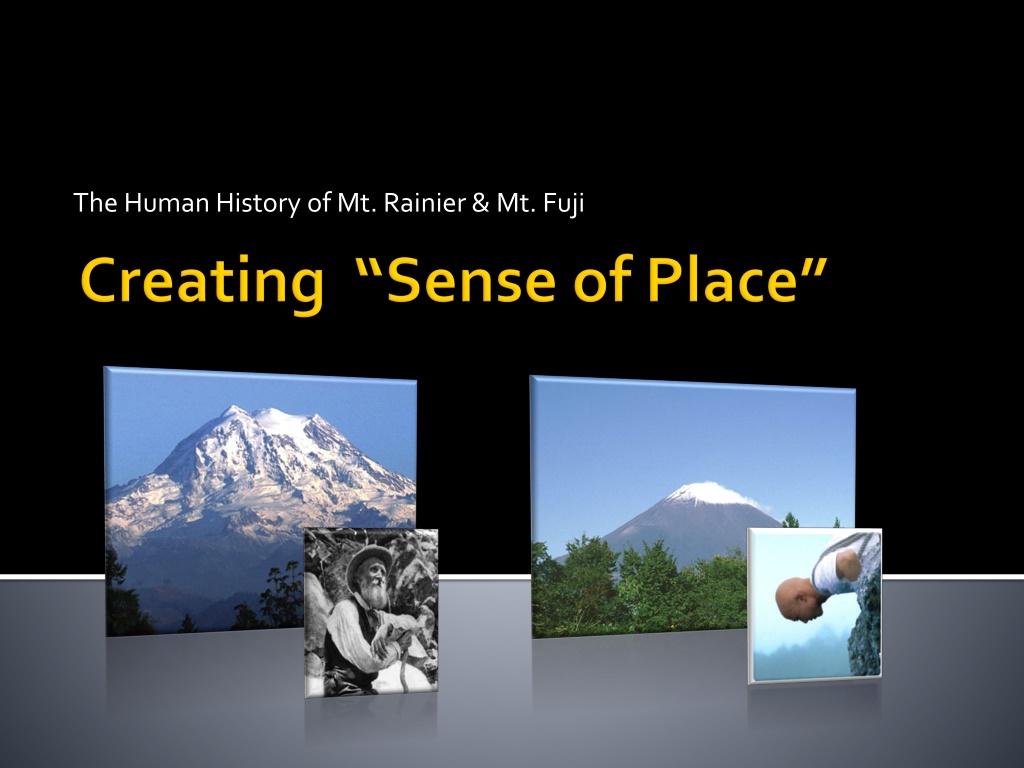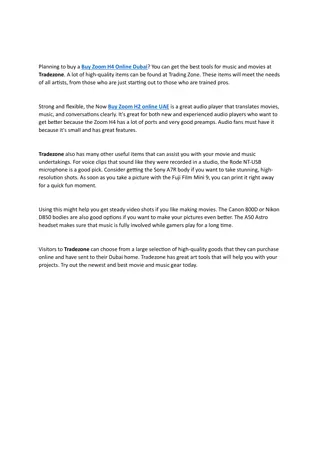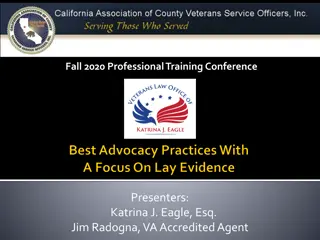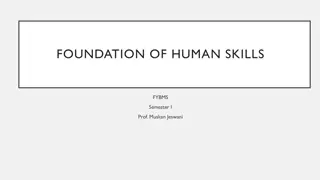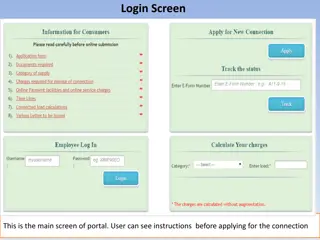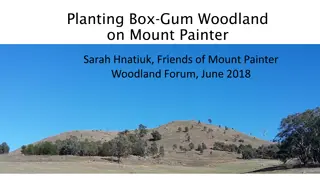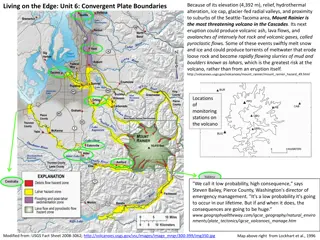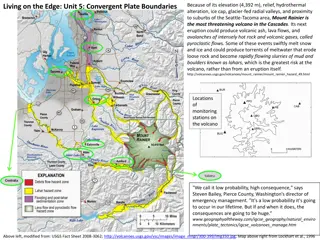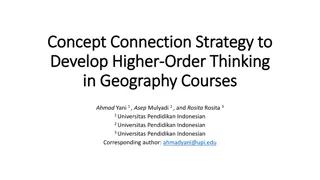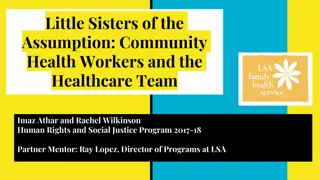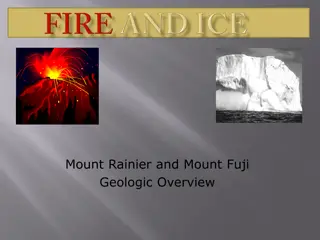Exploring Human Connection to Mount Rainier and Mount Fuji
This educational material focuses on understanding how humans have developed a sense of place with Mount Rainier and Mount Fuji throughout history, leading to efforts to conserve and protect these significant locations. Students will delve into the unique connections individuals have with special places, the importance of preserving these places, and ultimately create persuasive letters advocating for the protection of Mount Rainier and Mount Fuji.
Download Presentation

Please find below an Image/Link to download the presentation.
The content on the website is provided AS IS for your information and personal use only. It may not be sold, licensed, or shared on other websites without obtaining consent from the author. Download presentation by click this link. If you encounter any issues during the download, it is possible that the publisher has removed the file from their server.
E N D
Presentation Transcript
This lesson is about students learning how humans throughout history have developed a sense of place, or identity, to Mount Rainier and Mount Fuji, and how this identity has led them to conserve and protect these special places.
An individuals connection and interpretation of a particular area How we feel about places Deeply rooted in our history where you are, is who you are We all hold special connections to various places Mt. Rainier & Mt. Fuji both have had historical figures who have developed a sense of place
Sense of place has led people throughout history to want to protect places Both mountains have people/groups who have wanted to protect the area
What makes a place special to you? How are people around the world connected to special places? Why would people want to preserve and protect special places? What place would you want to protect? Why?
How humans have interacted with their environment throughout history.
Created for grades 10-12 Suggested 5-6 days Classroom based Field optional with extensions
students will develop an understanding of what "sense of place" means how this idea has led people throughout history to fight for land preservation and protection apply their understanding of sense of place and preservation/protection develop a persuasive letter urging the protection on Mt. Rainier/Mt. Fuji. Various adaptations included
Note important figures from history and their connection to land and the their calls for preservation Explain what sense of place means and how one creates such a feeling/identity. Understand what land protection and preservation is and why it is conducted. Discuss how land preservation and protection has been conducted nationally and internationally. Understand how there are various stakeholders to one-piece of land and different interpretations of protection exist. Analyze historical documents and interpret their call for preservation and protection. Use and understand the mentioned vocabulary in a fluid and cohesive letter. Write a letter to government officials where they persuade them to protect and preserve an important place using a specific stakeholder s sense of place as justification. Analyze text to determine its relation to sense of place and protection/preservation.
Bio-regionalist Stakeholder Preservation Conservation UNESCO Empowerment Composite volcano Yamabushi stewardship
Zenjo Summit Shinto Biosphere reserve Torii Empowerment Takhoma World heritage site
NISQUALLY TRIBE JOHN MUIR PRESIDENT WILLIAM MCKINLEY FAY FULLER JAMES LONGMIRE PUYALLUP TRIBE U.S. NATIONAL PARK SERVICE
MATSUDAISHONIN FUJISAN CLUB JIKIGYO MIROKU FUJI-KO IDA FOLLOWERS OF SHUGENDO KAKUGYOHASEGAWA
A Sense of Place if you don't know where you are, you don't know who you are. difference between living on the land and dwelling in it understanding its rhythms, its potential, and its limits. Your bioregion is a unique place with its own watershed, soils, climate, plants, animals, and history. Living in place means consciously trying to satisfy your needs and find your pleasures in your local bioregion and working to assure the long-term health of the bioregion Mapping can be learned by local groups and individuals to give a new sense of place. Responsibility to Place Knowing Your Bioregion Living in Place Mapping Your Place Building Local Community A bioregionalist assumes responsibility for the health and continuity of a place, not only its natural features, but also the social bonds of its people. Empowerment Knowing a place can inspire and empower one to take action to preserve it or take part in its restoration
Your sense of place! (Pick your school, your park, forest, lake, city, state, country, etc.) 1. How are you defined by your place? 2. How do you/can you accept responsibility of your place? 3. What history do you know of your place? 4. How do you find pleasure/happiness in your place? 5. How do you relate to your surroundings of your place? 6. How do you take responsibility of your place? 7. Why do you think empowerment is important in protecting/preserving your place?
Defining sense of place (Americas Best Idea) In addition to the scientific value as repositories of geological and biological diversity and knowledge, national parks have profound spiritual and cultural significance for the American people. The idea of nature as a place of inspiration and renewal played a key role in the creation of the National Park Service in 1916
1. How can people escape daily distractions of their cluttered lives by visiting national parks? 2. How did John Muir play a key role in creating the national park service? 3. Discuss what the "beauty and grandeur" of national parks have inspired. 4. Explain how the national parks have served as cultural icons of national heritage and identity by providing specific examples from the text. 5. Explain how American Indians hold spiritual values to what are now national parks providing specific examples from the text. 6. How has America s best idea led to others around the world to protect and preserve important places?
Reading about historical figures and their sense of place Students will read from various sources, including primary documents, from various groups/individuals and interpret what their sense of place is (why the mountain(s) are so important/special to them.
[The water was "an antidote for disease, prepared in Nature's own laboratory.... Why go abroad,'' Longmire's ad read, "when you may find Nature's own restoratives at your very doors?" In 1893, with the help of his family and Indian laborers, Longmire widened the trail to the springs into a rough wagon road. By 1896, the road was negotiable by stagecoaches. Gradually, the enterprise grew into a full-fledged tourist attraction, with a hotel, guest cabins, two bathhouse and stables.]
"an antidote for disease, prepared in Nature's own laboratory.... Why go abroad,' Longmire saw the mountain as medicine, a cure all. His sense of place revolved around using the natural medicine as a mode to profit He wanted to bring as many to see the mountain, and to profit it from it. It is special because of its natural healing processes, and of course profitability.
When Kakugyo, the founder of Fujii-ko, had stood immobile in his cave inside Mount Fuji, he had been trying through his meditation to restore stability to a nation rocked by political and social unrest. He hoped in this way to transfer the calm serenity of the mountain as the axis of the universe to the people of Japan, who had been fighting against themselves in an endless series of civil wars.
Saw the mountain as a way to promote stability and peace Used the mountain as a way to express serenity for his people saw the mountain as a place to meditate- a place to gain inspiration to help his people It is special because it provides inspiration to help his people.
Students analyze the historical figures interpretation of sense of place and how these special places have lead to conservation.
Preservation is about deciding what's important, figuring out how to protect it, and passing along an appreciation for what was saved to the next generation. Preservation is hands on. National Park Service archeologists, architects, curators, historians, and other cultural resource professionals work in America s nearly 400 national parks to preserve, protect, and share the history of this land and its people.
What is important to people, and how it should be protected Providing access to future generations- a hands on approach Share the history of our land and it s people
How sense of place has led to conservation (Americas Best Idea) In short, a biosphere reserve enlisted compromise, lest the people living closest to it not be supportive. Outside the core or a protected area and its buffer, a transition zone allowed development. The object of a biosphere reserve remained sustainability for both people and the land. Ideally, any community could learn to respect its surroundings and responsibility to develop a resource base.
1. Explain the roles and functions of the Wilderness Act of 1964. 2. Explain how UNESCO developed ideas of protection and preservation on a global scale. 3. Explain what a biosphere reserve is. 4. Discuss what a world heritage site is and the issues surrounding the idea. Explain the criteria for such a site. 5. Discuss in your own words, why conservation is important to the world as a whole.
Students will create a persuasive letter, developing a sense of place and urging conservation of an important place.
Imagine that you hold a special connection to Mt. Rainier/Mt. Fuji, and that you have developed a sense of place to the mountain. Recent economic downturns have led the government to open discussions that would allow for privatization of the entire mountain, meaning an individual would be allowed to purchase a parcel of land and construct permanent buildings or settlements without restrictions. There is a great deal of interest amongst the public, and there are projections that suggest all land would be sold, generating much needed funds for the government. Such actions would destroy current preservation attempts (clean water/air, natural resources, animal protection, etc.) and eliminate public-use of the land. Your job, as a particular stakeholder, is to write a letter to your government where you address the issue at hand requesting that the land be preserved and protected. You are to discuss the following, always connecting your ideas to sense of place (your connection to the land): The following are suggested criteria for a five paragraph letter. You must also include 3-5 of the vocabulary words within your letter. What is worth more, ones sense of place and preservation/protection, or the profit from the land/resources?
Preservation Presentation: Compare & Contrast Create a multi-media (PowerPoint, Prezi, etc.) presentation where you complete the following through research. Be sure to address each topic for each mountain. Pick one historical figure from both Mt. Fuji and Mt. Rainier. Explain what protection and preservation is. Explain what sense of place means and how it is developed. Explain how the historical figure developed a sense of place to the mountains. Explain how historical figures promoted preservation and protection of the mountains. Explain the current state of preservation and protection of the mountains. Explain how similarities and differences of protection and preservation for each mountain Include visuals (pictures, videos, charts, etc.)
Taking on the Role Students will take on the role of a historical figure or group from either Mt. Fuji or Mt. Rainier who has/have fought for preservation and protection of the mountain. Students will dress the part and provide a presentation for their peers where they address how they have developed their sense of place to the mountain (why it is a special place to them) and why they believe it is important to protect and preserve it, using information they have learned throughout this lesson.
Investigation Interview various people who have a connection to Mt. Rainier or Mt. Fuji. This could also be a student-to-student interview where each student picks a location where they have developed a sense of place and are asked questions about it. Students will want to focus on an essential question such as (what makes this place special to you and why is it worth protecting?) Students are to first pick their place of significance and brainstorm possible people to interview (various viewpoints are desired) Students are to create a series of questions (ten or more) to ask Students will share their results with the class. Suggestions below. Mock interview (one student asks, the other responds) PowerPoint Play recordings Place-based options: students can visit a particular place to interview various people and their interpretations of sense of place ; i.e., at the national park (park ranger, shop owner, climbers, etc.)
Preservation Pamphlet Create a pamphlet that urges the community to protect and preserve a particular place (Mt. Rainier/Mt. Fuji, or another place) by completing the following suggested guidelines below.
